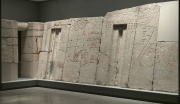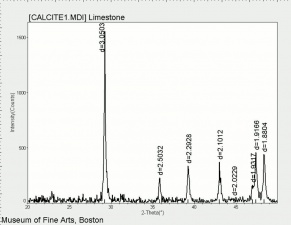Difference between revisions of "Limestone"
m (Text replace - "== Authority ==" to "== Sources Checked for Data in Record ==") |
|||
| Line 39: | Line 39: | ||
B.Aston, J.Harrell, I.Shaw, "Stone" in ''Ancient Egyptian Materials and Technology'', P.Nicholson, I.Shaw (eds.), Cambridge University Press, 2000, p. 40-43. | B.Aston, J.Harrell, I.Shaw, "Stone" in ''Ancient Egyptian Materials and Technology'', P.Nicholson, I.Shaw (eds.), Cambridge University Press, 2000, p. 40-43. | ||
| − | == | + | == Sources Checked for Data in Record == |
* ''Encyclopedia Britannica'', http://www.britannica.com Comment: "limestone" Encyclopædia Britannica [Accessed January 22, 2002 | * ''Encyclopedia Britannica'', http://www.britannica.com Comment: "limestone" Encyclopædia Britannica [Accessed January 22, 2002 | ||
Revision as of 06:30, 1 May 2016
Description
A fine-grain, sedimentary rock. Limestone is composed primarily of Calcium carbonate in the form of Calcite or Aragonite. Trace amounts of Dolomite, iron oxide, Quartz, Clay, or organic particles can also be present. Due to these impurities, limestone can vary in color from a cream to yellow to pink to brown to dark gray. Limestone is formed from compressed and cemented seashells and marine animal skeletons (reefs) or reprecipitation (stalactites, stalagmites). It is softer and more easily worked than marble. Chalk is a soft, porous, fine-grain limestone. Coquina is a porous, soft limestone made up of visible shell fragments. Limestone is used as a building stone and for sculpture as well as in the manufacture of Lime, Carbon dioxide, and Cement.
Synonyms and Related Terms
quina; caliza (Esp.); calcaire (Fr.); calcário (Port.); Kalkstein (Deut.); kalksteen (Ned.)
Other Properties
Soluble in acids with the evolution of carbon dioxide gas.
| Composition | CaCO3 |
|---|---|
| CAS | 1317-65-3 |
| Mohs Hardness | 3.0 - 4.0 |
| Density | 2.1-2.7 |
Hazards and Safety
No significant hazard. Noncombustible.
Additional Information
B.Aston, J.Harrell, I.Shaw, "Stone" in Ancient Egyptian Materials and Technology, P.Nicholson, I.Shaw (eds.), Cambridge University Press, 2000, p. 40-43.
Sources Checked for Data in Record
- Encyclopedia Britannica, http://www.britannica.com Comment: "limestone" Encyclopædia Britannica [Accessed January 22, 2002
- G.S.Brady, Materials Handbook, McGraw-Hill Book Co., New York, 1971 Comment: limestones density = 1.164 - 2.483; calcite density = 2.71
- Dictionary of Building Preservation, Ward Bucher, ed., John Wiley & Sons, Inc., New York City, 1996
- C.W.Chesterman, K.E.Lowe, Audubon Society Field Guide to North American Rocks and Minerals, Alfred A. Knopf, New York, 1979
- Michael McCann, Artist Beware, Watson-Guptill Publications, New York City, 1979
- Thomas C. Jester (ed.), Twentieth-Century Building Materials, McGraw-Hill Companies, Washington DC, 1995
- Ancient Egyptian Materials and Technologies, Paul Nicholson, Ian Shaw (eds.), Cambridge University Press, Cambridge, 2000 Comment: B.Aston, J.Harrell, I.Shaw, "Stone"
- Van Nostrand's Scientific Encyclopedia, Douglas M. Considine (ed.), Van Nostrand Reinhold, New York, 1976
- The American Heritage Dictionary or Encarta, via Microsoft Bookshelf 98, Microsoft Corp., 1998
- Website address 1 Comment: http://www.marble-institute.com
- CRC Handbook of Chemistry and Physics, Robert Weast (ed.), CRC Press, Boca Raton, Florida, v. 61, 1980 Comment: density=2.68-2.76


